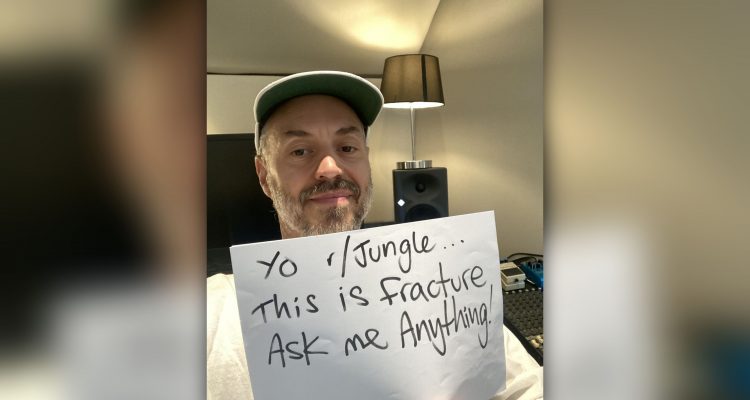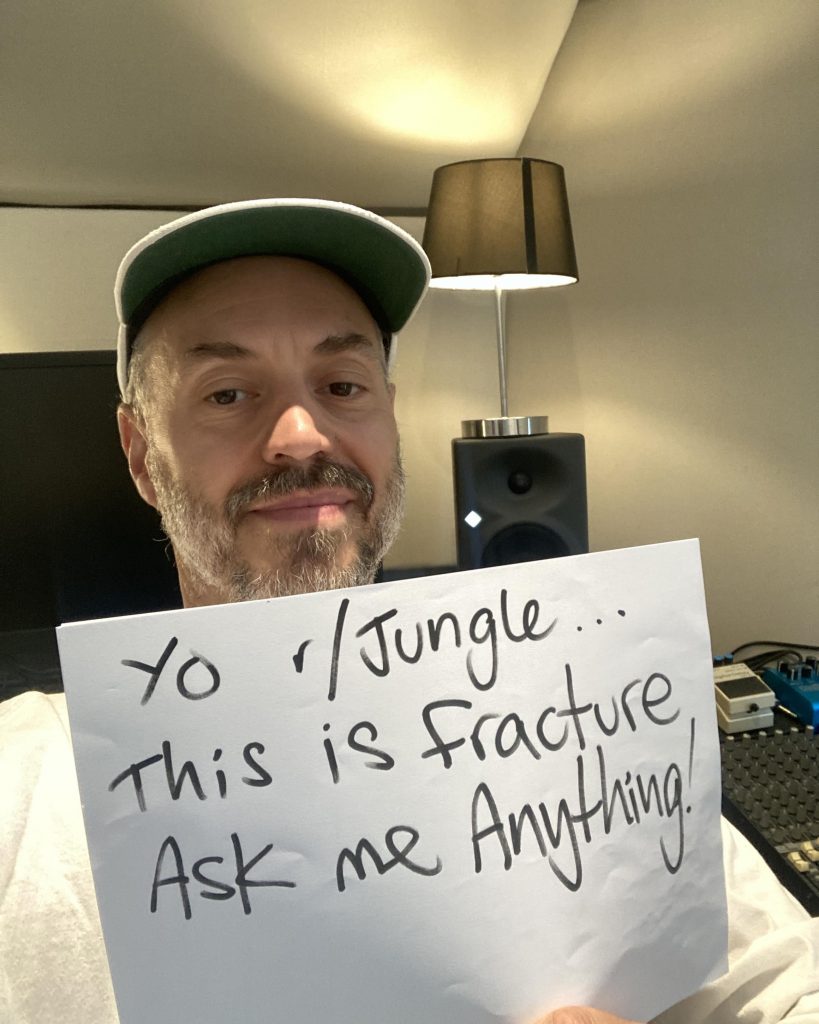Fracture has long been one of Jungle and Drum & Bass’s most distinctive producers. Known for sharp breakwork, deep sampling, and a constant respect for the culture’s roots, he recently took part in an AMA (Ask Me Anything) on r/Jungle.
For those unfamiliar, an AMA is a Reddit Q&A where fans put questions directly to artists. What made this one stand out was how open Fracture was about his creative process, his influences, and his views on where the music is heading. Below are some of the key highlights that reveal both his craft and his perspective.
On the art of breaks
One of the recurring themes in Fracture’s replies was the balance between precision and feel. Tightening up a break can bring clarity, but go too far and the groove disappears.
As he put it: “One of the things I’m always striving for is to retain as much of the break’s original sound and vibe as possible while tightening hits and quantising. If you quantise some breaks too much they can totally lose the original feel.”
It’s a reminder that break manipulation isn’t just technical; it’s about preserving the character that made those rhythms so compelling in the first place.
How an album concept comes together
Fracture also spoke about the way his last album took shape. What started as a loose idea turned into something far more deliberate once the right spark arrived.
He explained that the whole project began with a simple sample- Eastman saying “0860.” At first, it seemed like just another idea for a track, but it quickly grew into the foundation for a full album.
From there, the process became more structured. Fracture “mood boarded” the aesthetic, built up a large library of sounds by sampling pirate radio tapes, and prepared breaks that matched the vision. The key was working with focus rather than waiting for inspiration to strike.
As he put it: “The whole writing of that album was quite an eye opener for me in terms of the importance of focussed preparation.”
Advice for producers
For those hoping to follow in his footsteps, Fracture’s advice was straightforward: don’t overcomplicate things. Preparation is everything, but so is speed and enjoyment.
He stressed the value of working quickly and setting yourself up with the right tools and ideas before diving into a track. More than that, he reminded producers not to lose sight of what excites them: “Try to work quickly and spend time on preparation. Also making things fun and use what excites you.”
It’s a practical approach- keep the workflow moving, stay prepared, and focus on what makes the music fun in the first place.
First raves and early influences
Looking back at his own journey, Fracture recalled the mid-90s rave scene that first pulled him in. His early experiences weren’t strictly Jungle, but Happy Hardcore- a sound he remembers at its peak in ’94 and ’95.
“It was like a cross over between piano hardcore and rude Jungle,” he said, pointing to Slammin’ Vinyl, Slipmatt, Labyrinth, and Dream FM all-nighters as formative experiences. For anyone who didn’t live through that time, it’s a vivid snapshot of how the rave spectrum overlapped before genres began hardening into distinct identities.
Who inspires him today
When asked about who’s pushing Jungle forward right now, Fracture singled out Sully. His track on Fabric stood out as a clear highlight, bringing something fresh while still sounding unmistakably Jungle.
As Fracture put it, Sully has a way of delivering new material that always feels different yet still connects with the core of the genre. It’s high praise, and a reminder of how new generations keep the culture alive by building on the foundations rather than repeating them.
Music technology: progress and limits
Fracture also reflected on the tools of the trade. While modern software like Ableton 12 is powerful, he feels the real breakthroughs belong to an earlier era.
“It’s advanced greatly in terms of how quickly you can do things now or how much storage you can have,” he explained, “but ultimately there hasn’t been anything as exciting as the invention of the sampler or the drum machine.”
For him, classics like the Akai 950’s time-stretch, the 303, or the 808 defined sounds that remain iconic today. DAWs, no matter how advanced, don’t carry the same cultural weight. The tools might be sharper, but the magic lies in how they’re used.
On culture and the internet
Beyond production, Fracture also touched on how the internet has shaped culture itself. He drew on the late journalist Mark Fisher’s idea of ‘The Slow Cancellation of the Future’, where cultural time feels flattened- everything happens at once, and nothing is truly “retro” anymore.
In that sense, Jungle today isn’t just nostalgia or revival; it sits alongside everything else in the present. For listeners and producers alike, this creates both endless possibilities and a strange sense that history is always looping back on itself.
Big inspirations
Looking at who shaped his sound, Fracture pointed to names inside and outside Jungle. Danny Breaks was a big influence in the late ’90s with what he described as “cosmic Jungle,” while Paradox inspired his love of breaks.
But his sampling ear also wandered far beyond electronic music. Early Fracture & Neptune tracks drew on artists like Steve Miller, Henry Mancini, and Philip Glass. The aim wasn’t to copy them directly but to translate their feel into the Drum & Bass world: “We were often trying to make something that sounded like those guys but in a DnB world.”
Where he’s heading now
As for the present, Fracture is exploring a more stripped-back approach. He’s experimenting with tracks built from as few elements as possible, with minimal processing, taking cues from Jungle classics like ‘Terrorist’, ‘Set Speed’, and ‘Burial.’
“It’s really hard to do well,” he admitted- but that challenge is part of the point. It’s a move that shows his respect for simplicity, and his belief that sometimes less really can be more.
Respect For The Craft
What shines through in Fracture’s AMA is a deep respect for Jungle’s past paired with a restless drive to keep experimenting. Whether it’s talking about the feel of a break, the icons of early rave culture, or the philosophical effects of the internet on music, his answers reveal both precision and curiosity.
AMAs like this remind us why Jungle continues to evolve, not just through new technology or trends, but through artists willing to share knowledge, reflect on their roots, and push the sound in new directions.



